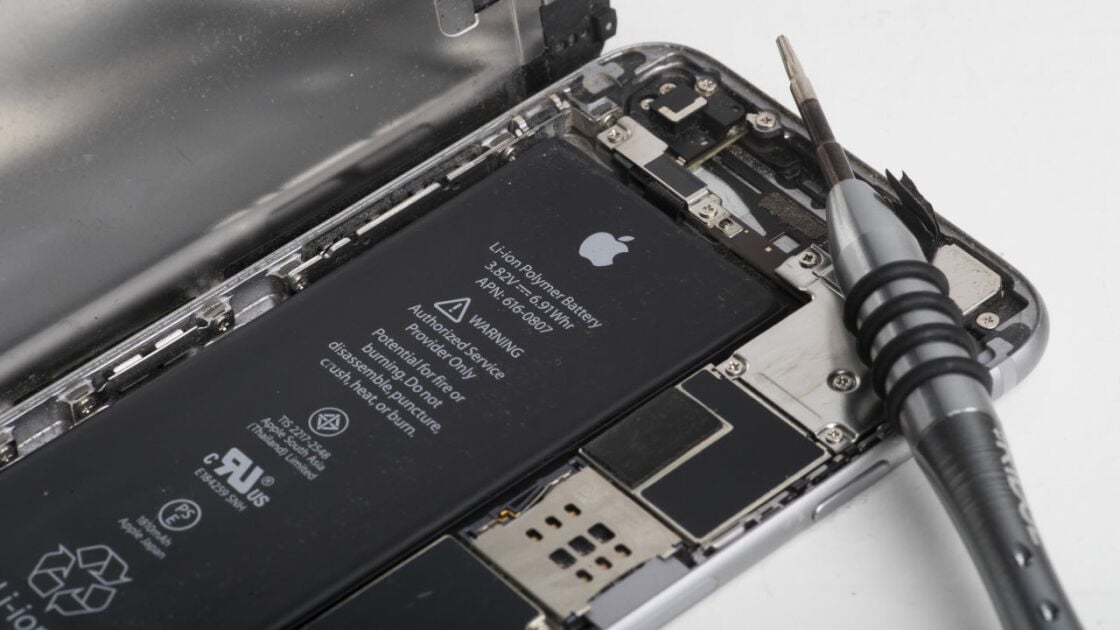
Say what you want about the EU, but at least they keep greedy companies in check as much as they can.
They could certainly do better, but they do quite a bit yeah.

For sure, but it’s better than nothing. Imagine the world without the EU… shudders
Yeah, agreed

Well… for iPhones (and other smartphones) I’m not sure if anything changes. There is a exception in the regulation: if the device is waterproof, it is enough if the manufacturer or repair shops can change the battery for you. They do not need to be user replaceable.
But probably for MacBooks, there will be replaceable batteries in the future. I don’t see, how Apple will find a way around this regulation.
Apple Watch: they are waterproof —> nothing changes.
AirPods: well… are they waterproof? I don’t see user changeable batteries ever. Perhaps they will become waterproof in the future too? :) AirPods, now also for swimming and diving!
iPads: well: probably there will be changeable batteries in the future. Or we will have underwater Tablets soon. We just need another input method. Probably gestures like the VisionPro?

It’s not just Apple. Almost all manufacturers offer water resistant flagship phones (and mid-rangers). ASUS, Xiaomi, Oppo, Huawei, Sony, Samsung, Vivo, Honor…
However, the phones are NOT water-proof. From none of these (neither Apple). They are water-resistant, which is a big difference and they are just required to not be damaged if submerged underwater for 30 minutes, 1.5m, if they want IP68.
Phones and smartwatches are not resistant to condensation or water getting in – water can still get in, as they’re NOT impervious (smartwatches if they have speakers), which is actually required for calling your device truly “water proof”. Water resistant is literally two steps below that.
There has been some marketing claiming water proof devices. This was just wrong.

Interesting. Apple itself says, „Apple Watch Ultra has a water-resistance rating of 100 meters“.
If even being officially able to dive until 40m and use the Ultra as a dive computer, doesn’t make it waterproof but just water-resistant?
What does it need to be waterproof? Being able to dive down the Marianne Trench?

How is “water proof” defined in the legislation? Apple carefully says their devices are water resistant. There is a possibility that it will not qualify.

The industry standard is the IP rating: https://en.wikipedia.org/wiki/IP_code The first digit is dust protection grade.
The second digit is water protection grade.
IP67 is a common consumer electronics requirement.

I love what the EU does to technology. Thank you EU!

For real, as an American I’m super grateful.

Being able to have a spare battery in case of emergency (or simply app train/bus tickets) is going to be nice. It’s going go be exciting to see how apple will try to circumvent this.

i believe the law is more about easily being able to replace a battery for repair than being able to swap it on the go

that would make sense. Being able to “easily remove and replace them.” is a little vague, i wonder if requiring a screwdriver could be considered easily removable.

We can relive having your phone explode into three separate pieces when you drop it! Seriously though, this is good news in my opinion.

I doubt they’ll circumvent this. They don’t seem to circumvent the mandated USB-C port if the rumors are to be trusted.

They already tried, given that the reason that they’ve held out for so long is because of one of those circumventions.
It’s just that the EU is clamping down, and Apple is running out of time on that restriction, hence them moving over to USB-C coincidentally just before the EU would force their hand.
Yeah. And battery issues are one of the biggest sources of new phone purchases. This is going to help reduce e-waste for sure.

“Exciting”

Not OP but yes, it is quite exciting tbh

I think I was unclear. I agree that having replaceable batteries is exciting. Ben sarcastically called Apple coming up with a way to circumvent the law exciting. And I agreed, also sarcastically.

Nono, you were being clear enough. It is exciting to see what and how Apple will be doing with this, and how they adapt (if the vote goes through).
Its like watching a roast-fight. And one just dropped something that made that crowd go “oooooh”

Lol. I get it now. Thanks

I think we reached a point where flagship phones are good enough to be used for more than 5 years. But the battery won’t live that long, for. most people. I’ve replaced my previous phone, after four years of using it, for the most part because of the battery. I’m looking forward to replaceable batteries returning and helping at least some of us keep our phones for a few more years.
Yes, for sure. My last phone lasted two months shy of 6 years, and was replaced because of a touch issue (a little strip across the screen no longer acted on touch, which made typing and other stuff completely impossible), and was only “fine” in regards to battery because it was a huge one to begin with (+4Ah for a 5" screen). The battery was definitely way worse than original, but still on par with some new phones today lol

That’s a generous timeline, but I’m sure manufacturers are whining about it anyway.
Naturally. Just a shame it isn’t a bit earlier :P

My Fairphone 3 already has replaceable batteries. What is really missing is an industry-standard form factor, like ATX/ITX exists for desktops.
If there were a standard, we’d be able to upgrade the components as needed. We wouldn’t be forced to waste perfectly good displays just because we would like to upgrade the CPU. Companies wouldn’t be pushing for new upgrades every year. Apple/Samsung wouldn’t be able to hold their dominance because it would be easier for smaller players to specialize in specific components. The entire maker community wouldn’t have to be fighting over Raspberry PI and we could even have a cottage industry around upcycled consumer electronics.

It’s the first time I hear about Fairphone. How they embrace repairability is amazing. I hope they’ll expand to North America at one point.

I’ve had this thought in the past, but upon further research, on a smartphone scale it runs into a few issues.
A PC has relatively divorced components because it has the space to accommodate slots, but that already goes out the window for laptops; the best you get is RAM and maybe MXM. People generally want slimmer and more battery-dense products, so motherboards with everything soldered can manage to be absolutely tiny (see: newer macbooks) compared to ones where everything is slotted. Newer smartphones don’t just last longer on battery because they’re bigger; much of the internal volume of a smartphone is now to hold the battery as everything around it shrinks. Modular connectors cost volume and money, for a use case where both are at a premium; most people would generally rather buy a non-modular phone that gets better battery life and offers better water resistance.
As evidenced by the Note 7, batteries also need a decent bit of structural integrity around them to be safe, and the best way to accomplish that is just a 2-part box that’s been glued together. This has the side effect of making water resistance easier and slimming the phone down. Any swappable battery inherently has worse water resistance and volumetric efficiency than a pouch csll in a glued box, and manufacturers value both good battery life and things not blowing up.
Smartphone CPUs (or rather SoCs) contain not only the CPU bit, but important parts of the radio, camera processing, location processing, and GPU. Therefore Android ones come with driver packs from manufacturers that make it all work, but if you’re swapping components around you need to make sure your sensors like cameras have a way to install drivers (and a general compatibility standard); which means at best you’re swapping pretty big chunks of a smartphone at a time.
Even without forced obsolescence, smartphones have a relatively fixed lifespan of ~5-8 years due to software upgrades, how carriers buy up new radio frequencies, physical damage, battery degradation, vibration motor wear, camera focusing mechanism wear (from vibrations) and in the case of AMOLED display wear. This isn’t a knock on standardization, but you can already achieve this lifespan out of a smartphone if you use something like Advanced Charging Controller to limit battery charge to 80%.
If you look at Project Ara (which is the most extreme case of modularity), it failed because of all of the above. The battery life, structural integrity, cost efficiency, compatibility, and waterproofness would all be awful compared to a standard phone.

People generally want slimmer and more battery-dense products
I call BS on that one. People say they want slim electronics and the first thing they do is to slap it in a protective case. It’s like SUVs and light trucks in the USA. People don’t even have the choice anymore because smaller cars are not as profitable, so then Ford goes to sell one gazillion F150s to soccer moms and then they claim “we are just fulfilling the demand of the market”.
My Fairphone seems bulky in comparison (and it is), but it is small enough that I can have it in my pocket.
(laptops) the best you get is RAM and maybe MXM
Is it really? With things like M2 slots you can get separate wifi adapters, fast storage. With Thunderbolt, we don’t even need a high-end graphics card in the laptop. We can do plenty with an iGPU and have an external, upgradeable GPU for those that want to game or do heavy work.
which means at best you’re swapping pretty big chunks of a smartphone at a time.
Fine by me. If we break down as CPU/storage/camera module/“everything else board”, then it’s 4 modules. Which is a lot more than what we are getting now and it’s the complete opposite of what manufacturers are giving us.
That would be quite utopian, however I feel such a thing would be incredible hard to achieve. Different form factors require different layouts, space is much tighter and should not be wasted. In desktop PC land, you have plenty of room to fit things as you want.
It may not be showstopper, but it’s certainly a challenge. And of course, companies won’t like it :P
I feel like the opposite: the constraints are so well-known and so well defined that most phones end up looking the same anyway, we might as well just take one of them (any of them!) and make it a standard.
companies won’t like it
Apple/Samsung surely won’t. But I’d bet that the smaller ones would like to have some type of level-playing field. Also, imagine the amount of startups that could come up in the space.
mm you bring good points! hadn’t thought of how it would level the playing field

So there’s going to be a catch here and I’m curious how it will work out. Integrating the battery directly into the phone without it being easily removable is going to mean less capacity since the battery will need a heavier-duty shell since you can’t rely on the phone itself for protection. I get the e-waste angle but generally I wouldn’t keep a phone past the end of updates anyways, and usually battery life is still acceptable at 4 years with good practices (not charging to 100% and holding it there overnight, etc).

My last two phones both got slow as their batteries got bad, and were basically like new after replacing them. My current phone doesn’t allow swapping the batteries.
For someone thrifty, being able to replace the battery can extend a phone’s life 2x or more. Even if you don’t want to keep using it, you could still resell it or give it to someone who doesn’t need the newest phones. Non-swappable batteries are a form of planned obsolescence, in addition to just being more compact and probably a little cheaper.

I’ve had my current phone for around 5 years. I’m on the latest LineageOS. I have no speed issues. The battery is starting to show signs of age. My previous phone had a longer life and got through two batteries. It was up to date with LineageOS until it’s last days. It was lack of RAM that did it in. My current phone still has mid level amount of RAM.
EU needs to look at updatablity next. If the vendors no longer provides real updates, they should unlock the bootloader. Really I want phones to like PCs and not require a custom OS each…

I imagine they can still use screws and the connectors like they do. The screws just need to be some place you can get to without having to use a heat gun to remove your entire damn screen.

Had to replace my previous phone due to bad battery.
Kept it safe, used cover and screen protection, but the battery got so bad it was not mobile anymore.
Now? Now all the complexity that went into making the phone is e-waste, what a shame.
Exactly! It bums me so much that the vast majority of the money you spent buying the device and of the money spent making the device is completely thrown out because you can’t replace a little component that was perfectly replaceable 10 years ago… 🙄

And not only money - resources and energy as well.
Yeah, exactly.

But they stopped including chargers so it’s basically carbon neutral now! /s

Well, the chargers were at least a step in the right direction (though probably with the focus more on consumer friendliness than environmental impact).

I’ve always wondered if there is a physical limitation why the battery couldn’t go in like a sim card? Just a slot where it goes in. I’m curious how this all will work out.

That’s pretty much how it used to work.
The main reasons why it changed are:
-
Space, as a connector is slightly bigger than a soldered connection, and the battery itself has to be slightly bigger and stronger too to be safe to transport and handle without being protected by the phone’s case.
-
Water resistance; it’s far easier to make a phone’s case waterproof by just glueing the whole thing shut than having to use seals and gaskets and such to make it possible to open and close it at will.
-

LG had some phones like that in 2016ish, on the G5 the entire bottom of the phone slid out to reveal a big battery slot and on the V20 there was a button that let the metal back of the phone pop off so you could change the battery. I had an external battery charger and a couple of spare batteries for my V20, so I could just pack spare batteries and swap them whenever it got low. I never even bothered to plug my phone in, it was always just faster to pop in a battery that was already fully charged. It didn’t have any water resistance, but it was a pretty small price to pay for endless battery life
It’s a shame that LG’s whole phone division went under, because they were making some of the coolest phones that came out that whole decade

That sounds pretty cool :)

@binboupan @tmpod I’d say it’s simply space. To make modern smartphones have enough power for the day, the battery has to be as large as possible. Generally, it’s sandwiched directly between the screen and the backcover.
The reason they’re not removeable anymore is because this way manufacturers don’t need to put the battery in a plastic casing, leaving more space for energy.
I mean, you could also just make the smartphones bigger, but people want them as flat as possible.
I don’t see an issue, but perhaps nobody ever thought to really try shipping a device with something like that. Specially since the water proofing advent.

Will the phones still be waterproof?

Louis Rossmann did a video on this and pointed out that there were phones that had IP67 (Samsung Galaxy S5) or even IP68 (some Sony phone) rating with user replaceable batteries. So yeah, they should be.

Not to mention there are a host of other products with ports and openings that are waterproof. Phones have slim packaging but rubber gaskets are even slimmer. My S21 Ultra is water resistant even with an open USB-C port.

I don’t see why they wouldn’t be.
It wasn’t all that long ago that we had waterproof phones, with similar ratings as current phones, whilst also having a replaceable battery.
The Samsung Galaxy S5 had an IP67 rating, for example, despite having a headphone jack, and a replaceable battery/removable back. (it also featured wireless charging, which was surprisingly forward for the time).
Good question. I’m sure there’s still ways to make them water proof, even if it requires some little screws. Still, I’d rather have replaceable battery rather than total water tight casing.

This comes at a time where I’m considering replacing my 5 year old phone battery due to significant degradation, but at the cost of my phone’s water resistance. I’m all for user repairability and really look forward to these consumer friendly changes.
Yeah, I support that decision :P
I personally don’t see that much value in water proofing, I’ve never came across a situation where I thought it would have been rather helpful to have water proofing. Maybe I’ve just been very lucky hehe
Unfortunately you’ll have to wait until 2027 so your current 5 year old phone will probably be long dead by that point.

Given the state of technology the battery decaying wasn’t the issue in my latest phones. It was performance of the device. Apps keep evolving and at some point your device just can’t keep up anymore.
Went from a Moto g6 I think to a Pixel3 and now a pixel 6 pro. Batteries can be charged everywhere, CPU’s can’t be overclock without limits.

In general, that’s definitely a problem too. Just look at Windows 11. Now M$ wants you to buy a new laptop such that their OS can run at all. I use a >10y old laptop with Linux. No performance issues for everyday use.

Going from Google-Android to LineageOS boosted the battery life of my old Smartphone by a factor 3 roughly. There where some Google-things consuming battery in the background, probably spying on me. Also using simple Apps from F-Droid helps to get a smooth experience.

I would love this to have a global impact, but I have a bad feeling phone manufacturers are going to create a special EU model to comply with this.

The other thing that seems to fail is USB-C connector. I wonder if the USB-C connectors in most phones last beyond 5 years. Mine still works but I cannot plug the device in and use it without it just falling out pretty quickly. The old micro USB plugs seem a little more robust.

This is dramatically the opposite of my experience. I’ve never had a usb-c port die, but the microUSB ports were fragile as heck.
I’ve had cheapo USB-C cables die but that’s because cheap.

Do you have a specific cable brand that might be better? I have tried multiple suppliers. Same.

Anker and Belkin both make high quality cables.

Anker is my go to and handles my kids cable abuse pretty well. I also echo the above person’s comment that USB-C has been way more robust than micro for me.

Wireless charging solves most of that.
mm maybe. connectors should definitely have a tiny magnet, but its still rare…


